MBA402 - Sustainability Assessment Report: Timberwell Constructions
VerifiedAdded on 2023/06/03
|14
|3606
|231
Case Study
AI Summary
This sustainability assessment report analyzes Timberwell Constructions, a residential development company, based on the GRI Sustainability Reporting Standards 2016. It specifically addresses economic, environmental, and social sustainability aspects. The economic analysis covers financial risks and opportunities related to climate change, incidents of corruption, and legal actions for anti-competitive behavior. The environmental section examines energy consumption, impacts on biodiversity (specifically the wallum sedge frog), and non-compliance with environmental laws. The social component investigates employee turnover, incidents of discrimination (ageism), and community engagement initiatives. The report highlights Timberwell's challenges, such as bushfire risks, corruption allegations, environmental fines, and workplace discrimination, while also noting their efforts to mitigate these issues through compliance measures, habitat conservation strategies, and updated anti-discrimination policies. The analysis provides a comprehensive view of Timberwell's sustainability performance and areas for improvement.
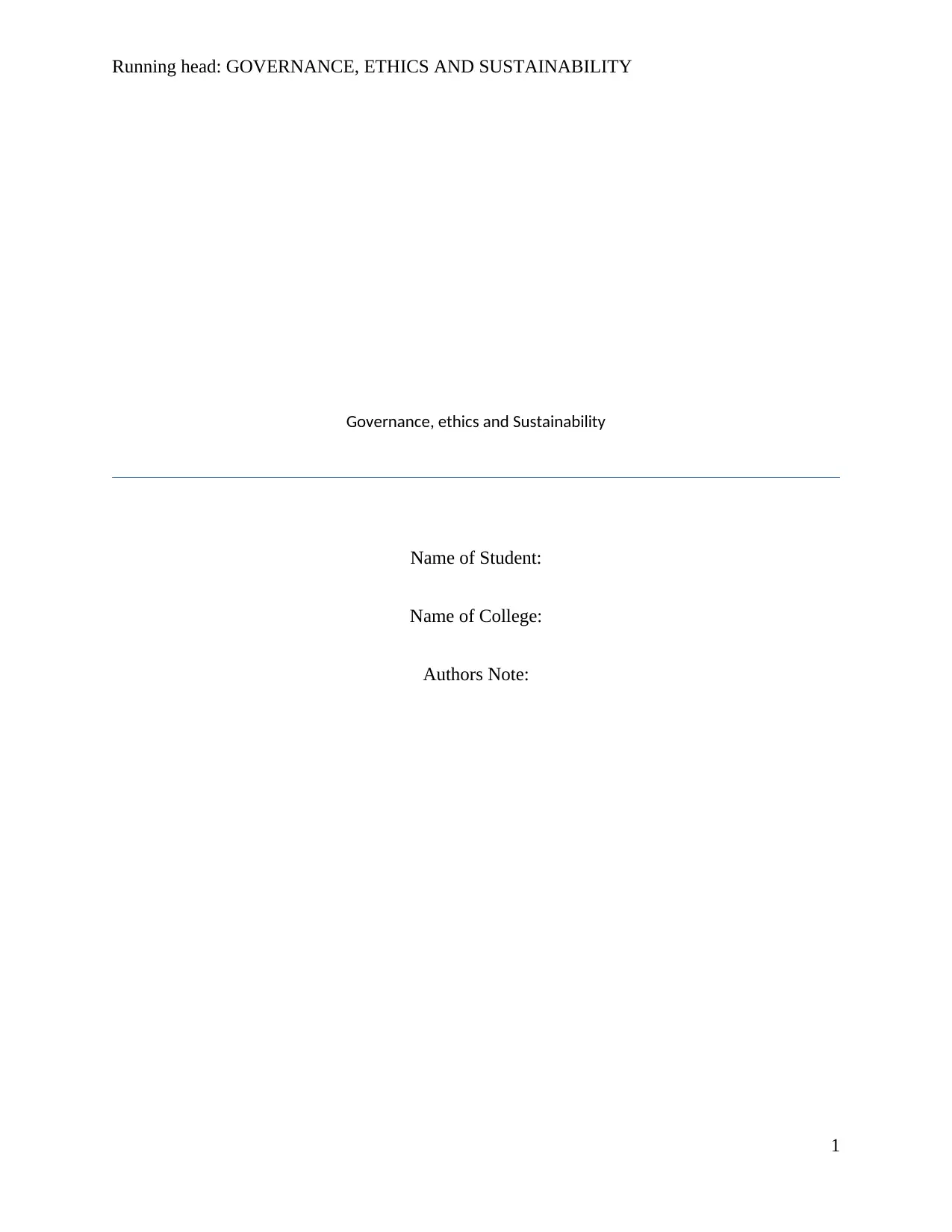
Running head: GOVERNANCE, ETHICS AND SUSTAINABILITY
Governance, ethics and Sustainability
Name of Student:
Name of College:
Authors Note:
1
Governance, ethics and Sustainability
Name of Student:
Name of College:
Authors Note:
1
Paraphrase This Document
Need a fresh take? Get an instant paraphrase of this document with our AI Paraphraser
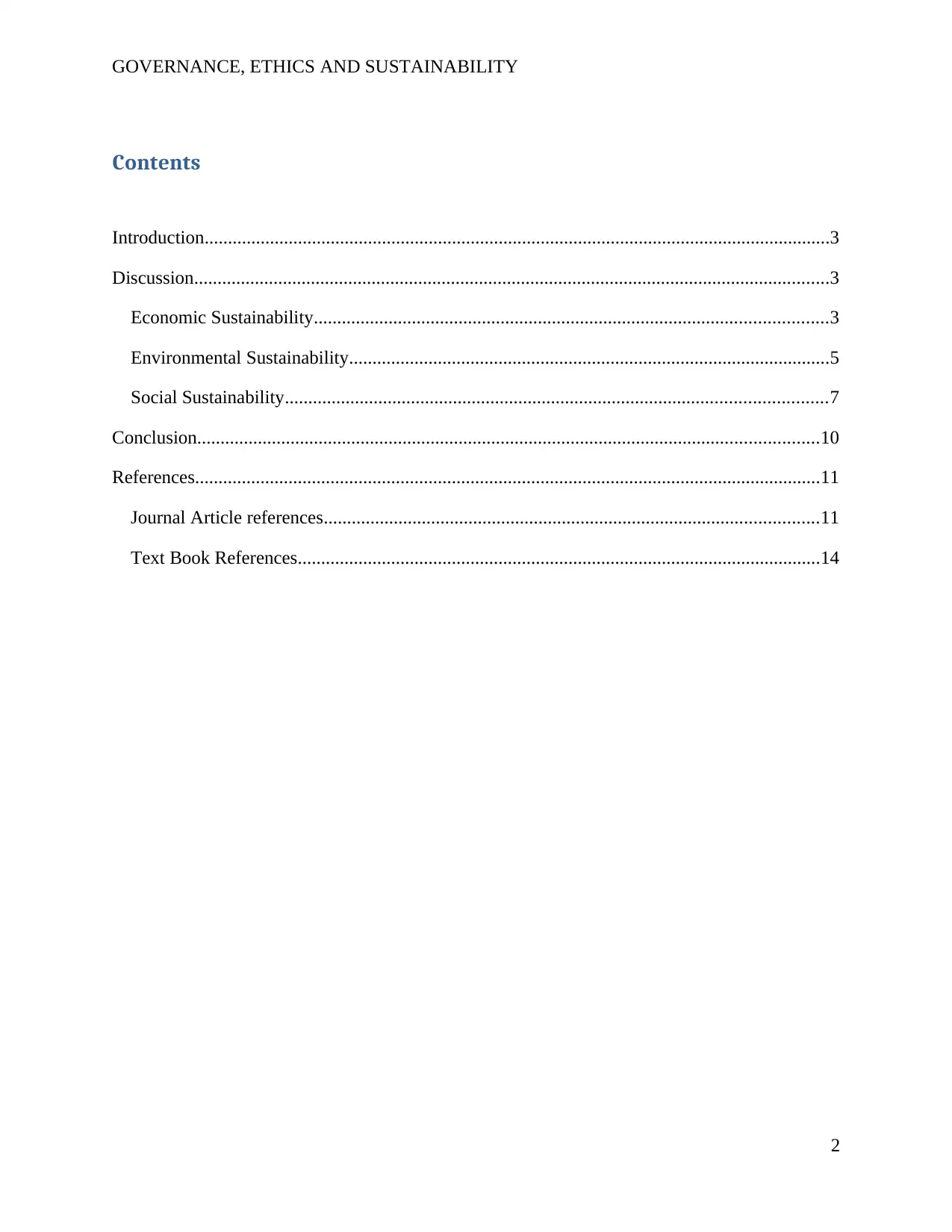
GOVERNANCE, ETHICS AND SUSTAINABILITY
Contents
Introduction......................................................................................................................................3
Discussion........................................................................................................................................3
Economic Sustainability..............................................................................................................3
Environmental Sustainability.......................................................................................................5
Social Sustainability....................................................................................................................7
Conclusion.....................................................................................................................................10
References......................................................................................................................................11
Journal Article references..........................................................................................................11
Text Book References................................................................................................................14
2
Contents
Introduction......................................................................................................................................3
Discussion........................................................................................................................................3
Economic Sustainability..............................................................................................................3
Environmental Sustainability.......................................................................................................5
Social Sustainability....................................................................................................................7
Conclusion.....................................................................................................................................10
References......................................................................................................................................11
Journal Article references..........................................................................................................11
Text Book References................................................................................................................14
2
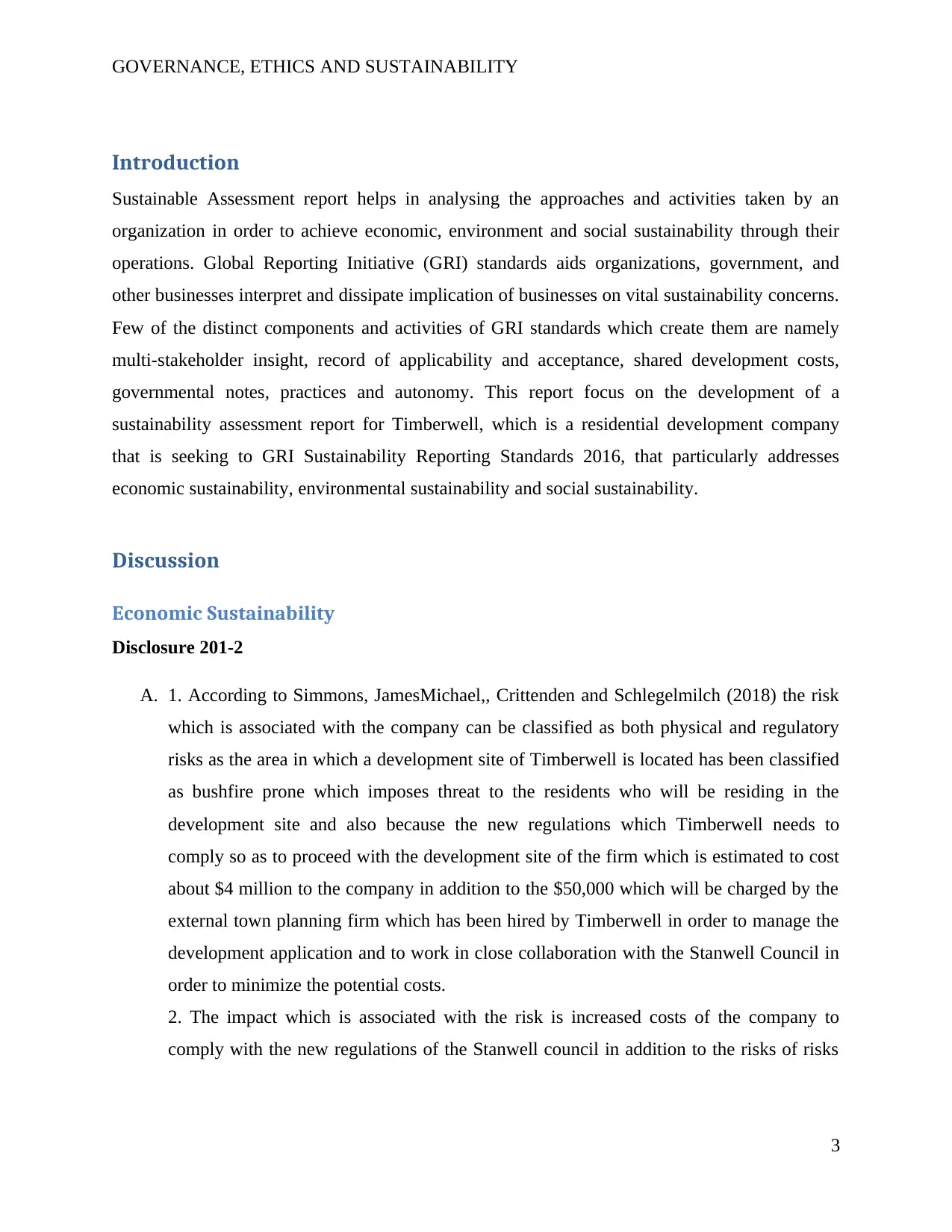
GOVERNANCE, ETHICS AND SUSTAINABILITY
Introduction
Sustainable Assessment report helps in analysing the approaches and activities taken by an
organization in order to achieve economic, environment and social sustainability through their
operations. Global Reporting Initiative (GRI) standards aids organizations, government, and
other businesses interpret and dissipate implication of businesses on vital sustainability concerns.
Few of the distinct components and activities of GRI standards which create them are namely
multi-stakeholder insight, record of applicability and acceptance, shared development costs,
governmental notes, practices and autonomy. This report focus on the development of a
sustainability assessment report for Timberwell, which is a residential development company
that is seeking to GRI Sustainability Reporting Standards 2016, that particularly addresses
economic sustainability, environmental sustainability and social sustainability.
Discussion
Economic Sustainability
Disclosure 201-2
A. 1. According to Simmons, JamesMichael,, Crittenden and Schlegelmilch (2018) the risk
which is associated with the company can be classified as both physical and regulatory
risks as the area in which a development site of Timberwell is located has been classified
as bushfire prone which imposes threat to the residents who will be residing in the
development site and also because the new regulations which Timberwell needs to
comply so as to proceed with the development site of the firm which is estimated to cost
about $4 million to the company in addition to the $50,000 which will be charged by the
external town planning firm which has been hired by Timberwell in order to manage the
development application and to work in close collaboration with the Stanwell Council in
order to minimize the potential costs.
2. The impact which is associated with the risk is increased costs of the company to
comply with the new regulations of the Stanwell council in addition to the risks of risks
3
Introduction
Sustainable Assessment report helps in analysing the approaches and activities taken by an
organization in order to achieve economic, environment and social sustainability through their
operations. Global Reporting Initiative (GRI) standards aids organizations, government, and
other businesses interpret and dissipate implication of businesses on vital sustainability concerns.
Few of the distinct components and activities of GRI standards which create them are namely
multi-stakeholder insight, record of applicability and acceptance, shared development costs,
governmental notes, practices and autonomy. This report focus on the development of a
sustainability assessment report for Timberwell, which is a residential development company
that is seeking to GRI Sustainability Reporting Standards 2016, that particularly addresses
economic sustainability, environmental sustainability and social sustainability.
Discussion
Economic Sustainability
Disclosure 201-2
A. 1. According to Simmons, JamesMichael,, Crittenden and Schlegelmilch (2018) the risk
which is associated with the company can be classified as both physical and regulatory
risks as the area in which a development site of Timberwell is located has been classified
as bushfire prone which imposes threat to the residents who will be residing in the
development site and also because the new regulations which Timberwell needs to
comply so as to proceed with the development site of the firm which is estimated to cost
about $4 million to the company in addition to the $50,000 which will be charged by the
external town planning firm which has been hired by Timberwell in order to manage the
development application and to work in close collaboration with the Stanwell Council in
order to minimize the potential costs.
2. The impact which is associated with the risk is increased costs of the company to
comply with the new regulations of the Stanwell council in addition to the risks of risks
3
⊘ This is a preview!⊘
Do you want full access?
Subscribe today to unlock all pages.

Trusted by 1+ million students worldwide
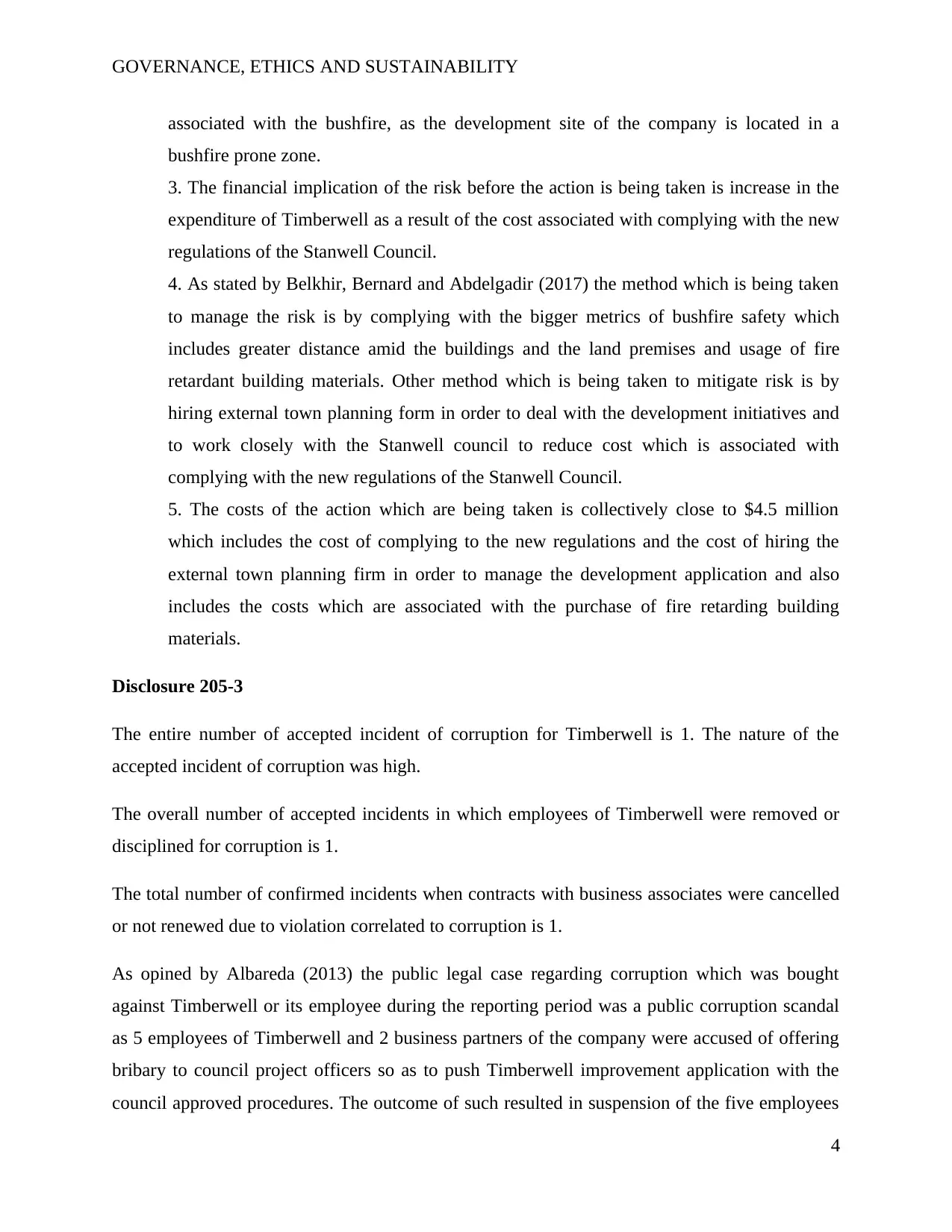
GOVERNANCE, ETHICS AND SUSTAINABILITY
associated with the bushfire, as the development site of the company is located in a
bushfire prone zone.
3. The financial implication of the risk before the action is being taken is increase in the
expenditure of Timberwell as a result of the cost associated with complying with the new
regulations of the Stanwell Council.
4. As stated by Belkhir, Bernard and Abdelgadir (2017) the method which is being taken
to manage the risk is by complying with the bigger metrics of bushfire safety which
includes greater distance amid the buildings and the land premises and usage of fire
retardant building materials. Other method which is being taken to mitigate risk is by
hiring external town planning form in order to deal with the development initiatives and
to work closely with the Stanwell council to reduce cost which is associated with
complying with the new regulations of the Stanwell Council.
5. The costs of the action which are being taken is collectively close to $4.5 million
which includes the cost of complying to the new regulations and the cost of hiring the
external town planning firm in order to manage the development application and also
includes the costs which are associated with the purchase of fire retarding building
materials.
Disclosure 205-3
The entire number of accepted incident of corruption for Timberwell is 1. The nature of the
accepted incident of corruption was high.
The overall number of accepted incidents in which employees of Timberwell were removed or
disciplined for corruption is 1.
The total number of confirmed incidents when contracts with business associates were cancelled
or not renewed due to violation correlated to corruption is 1.
As opined by Albareda (2013) the public legal case regarding corruption which was bought
against Timberwell or its employee during the reporting period was a public corruption scandal
as 5 employees of Timberwell and 2 business partners of the company were accused of offering
bribary to council project officers so as to push Timberwell improvement application with the
council approved procedures. The outcome of such resulted in suspension of the five employees
4
associated with the bushfire, as the development site of the company is located in a
bushfire prone zone.
3. The financial implication of the risk before the action is being taken is increase in the
expenditure of Timberwell as a result of the cost associated with complying with the new
regulations of the Stanwell Council.
4. As stated by Belkhir, Bernard and Abdelgadir (2017) the method which is being taken
to manage the risk is by complying with the bigger metrics of bushfire safety which
includes greater distance amid the buildings and the land premises and usage of fire
retardant building materials. Other method which is being taken to mitigate risk is by
hiring external town planning form in order to deal with the development initiatives and
to work closely with the Stanwell council to reduce cost which is associated with
complying with the new regulations of the Stanwell Council.
5. The costs of the action which are being taken is collectively close to $4.5 million
which includes the cost of complying to the new regulations and the cost of hiring the
external town planning firm in order to manage the development application and also
includes the costs which are associated with the purchase of fire retarding building
materials.
Disclosure 205-3
The entire number of accepted incident of corruption for Timberwell is 1. The nature of the
accepted incident of corruption was high.
The overall number of accepted incidents in which employees of Timberwell were removed or
disciplined for corruption is 1.
The total number of confirmed incidents when contracts with business associates were cancelled
or not renewed due to violation correlated to corruption is 1.
As opined by Albareda (2013) the public legal case regarding corruption which was bought
against Timberwell or its employee during the reporting period was a public corruption scandal
as 5 employees of Timberwell and 2 business partners of the company were accused of offering
bribary to council project officers so as to push Timberwell improvement application with the
council approved procedures. The outcome of such resulted in suspension of the five employees
4
Paraphrase This Document
Need a fresh take? Get an instant paraphrase of this document with our AI Paraphraser
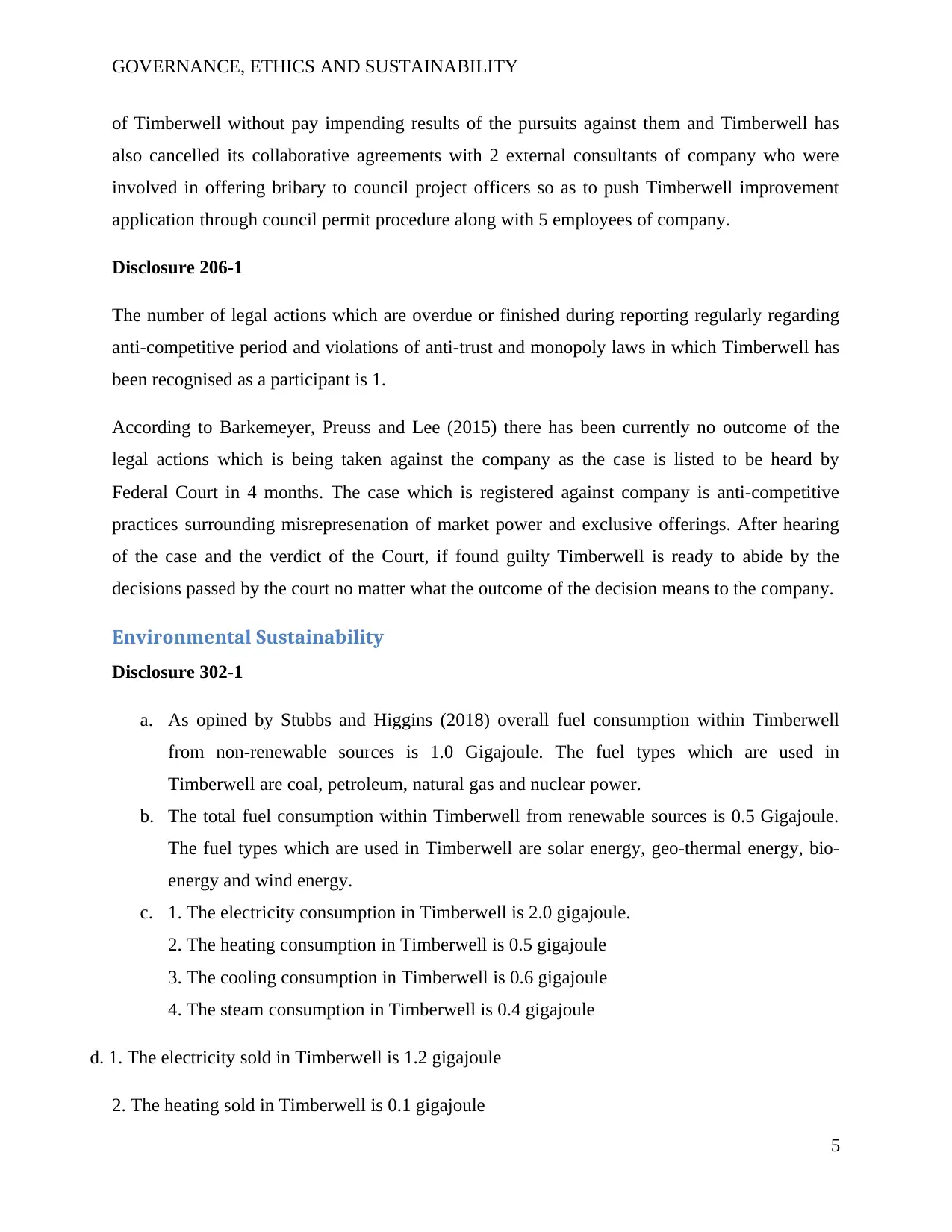
GOVERNANCE, ETHICS AND SUSTAINABILITY
of Timberwell without pay impending results of the pursuits against them and Timberwell has
also cancelled its collaborative agreements with 2 external consultants of company who were
involved in offering bribary to council project officers so as to push Timberwell improvement
application through council permit procedure along with 5 employees of company.
Disclosure 206-1
The number of legal actions which are overdue or finished during reporting regularly regarding
anti-competitive period and violations of anti-trust and monopoly laws in which Timberwell has
been recognised as a participant is 1.
According to Barkemeyer, Preuss and Lee (2015) there has been currently no outcome of the
legal actions which is being taken against the company as the case is listed to be heard by
Federal Court in 4 months. The case which is registered against company is anti-competitive
practices surrounding misrepresenation of market power and exclusive offerings. After hearing
of the case and the verdict of the Court, if found guilty Timberwell is ready to abide by the
decisions passed by the court no matter what the outcome of the decision means to the company.
Environmental Sustainability
Disclosure 302-1
a. As opined by Stubbs and Higgins (2018) overall fuel consumption within Timberwell
from non-renewable sources is 1.0 Gigajoule. The fuel types which are used in
Timberwell are coal, petroleum, natural gas and nuclear power.
b. The total fuel consumption within Timberwell from renewable sources is 0.5 Gigajoule.
The fuel types which are used in Timberwell are solar energy, geo-thermal energy, bio-
energy and wind energy.
c. 1. The electricity consumption in Timberwell is 2.0 gigajoule.
2. The heating consumption in Timberwell is 0.5 gigajoule
3. The cooling consumption in Timberwell is 0.6 gigajoule
4. The steam consumption in Timberwell is 0.4 gigajoule
d. 1. The electricity sold in Timberwell is 1.2 gigajoule
2. The heating sold in Timberwell is 0.1 gigajoule
5
of Timberwell without pay impending results of the pursuits against them and Timberwell has
also cancelled its collaborative agreements with 2 external consultants of company who were
involved in offering bribary to council project officers so as to push Timberwell improvement
application through council permit procedure along with 5 employees of company.
Disclosure 206-1
The number of legal actions which are overdue or finished during reporting regularly regarding
anti-competitive period and violations of anti-trust and monopoly laws in which Timberwell has
been recognised as a participant is 1.
According to Barkemeyer, Preuss and Lee (2015) there has been currently no outcome of the
legal actions which is being taken against the company as the case is listed to be heard by
Federal Court in 4 months. The case which is registered against company is anti-competitive
practices surrounding misrepresenation of market power and exclusive offerings. After hearing
of the case and the verdict of the Court, if found guilty Timberwell is ready to abide by the
decisions passed by the court no matter what the outcome of the decision means to the company.
Environmental Sustainability
Disclosure 302-1
a. As opined by Stubbs and Higgins (2018) overall fuel consumption within Timberwell
from non-renewable sources is 1.0 Gigajoule. The fuel types which are used in
Timberwell are coal, petroleum, natural gas and nuclear power.
b. The total fuel consumption within Timberwell from renewable sources is 0.5 Gigajoule.
The fuel types which are used in Timberwell are solar energy, geo-thermal energy, bio-
energy and wind energy.
c. 1. The electricity consumption in Timberwell is 2.0 gigajoule.
2. The heating consumption in Timberwell is 0.5 gigajoule
3. The cooling consumption in Timberwell is 0.6 gigajoule
4. The steam consumption in Timberwell is 0.4 gigajoule
d. 1. The electricity sold in Timberwell is 1.2 gigajoule
2. The heating sold in Timberwell is 0.1 gigajoule
5
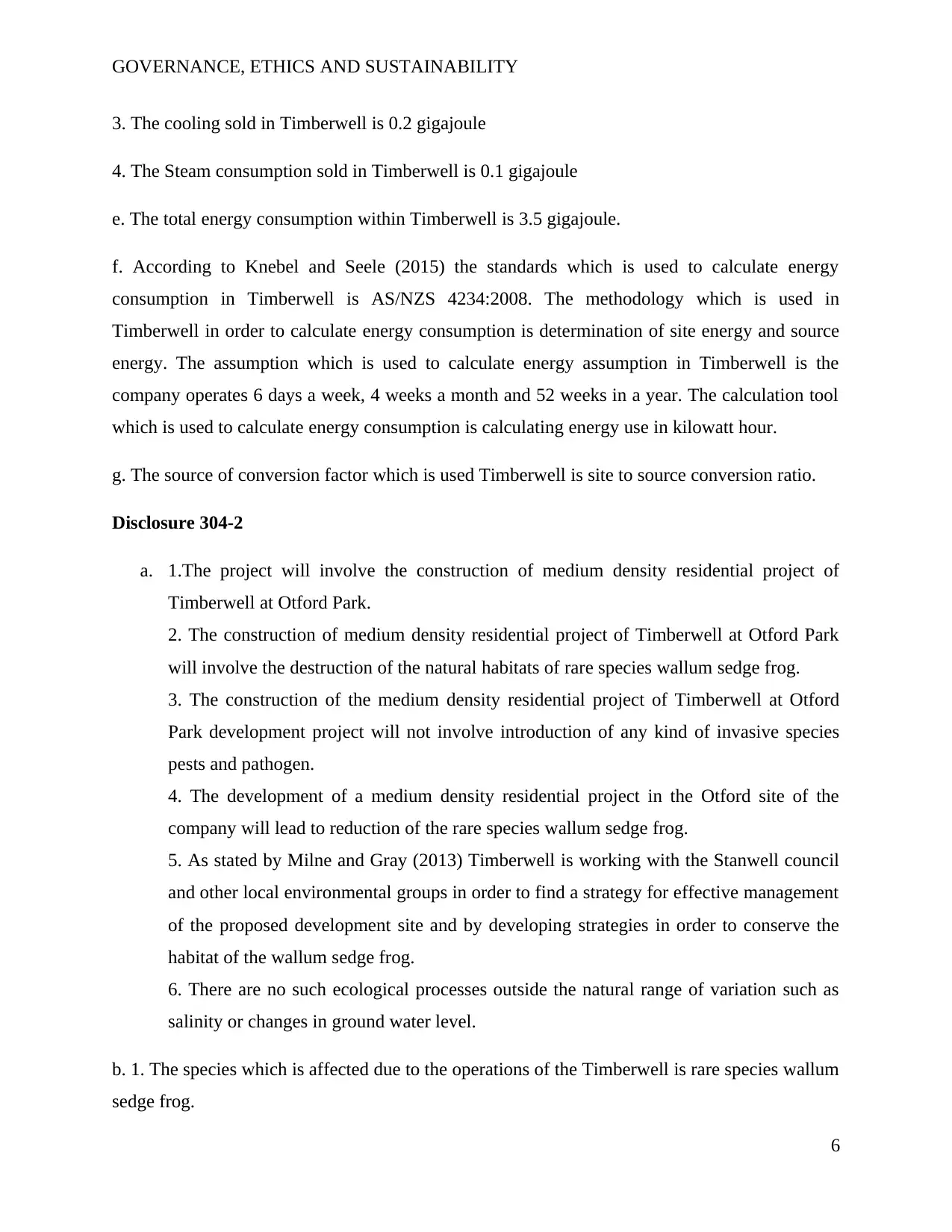
GOVERNANCE, ETHICS AND SUSTAINABILITY
3. The cooling sold in Timberwell is 0.2 gigajoule
4. The Steam consumption sold in Timberwell is 0.1 gigajoule
e. The total energy consumption within Timberwell is 3.5 gigajoule.
f. According to Knebel and Seele (2015) the standards which is used to calculate energy
consumption in Timberwell is AS/NZS 4234:2008. The methodology which is used in
Timberwell in order to calculate energy consumption is determination of site energy and source
energy. The assumption which is used to calculate energy assumption in Timberwell is the
company operates 6 days a week, 4 weeks a month and 52 weeks in a year. The calculation tool
which is used to calculate energy consumption is calculating energy use in kilowatt hour.
g. The source of conversion factor which is used Timberwell is site to source conversion ratio.
Disclosure 304-2
a. 1.The project will involve the construction of medium density residential project of
Timberwell at Otford Park.
2. The construction of medium density residential project of Timberwell at Otford Park
will involve the destruction of the natural habitats of rare species wallum sedge frog.
3. The construction of the medium density residential project of Timberwell at Otford
Park development project will not involve introduction of any kind of invasive species
pests and pathogen.
4. The development of a medium density residential project in the Otford site of the
company will lead to reduction of the rare species wallum sedge frog.
5. As stated by Milne and Gray (2013) Timberwell is working with the Stanwell council
and other local environmental groups in order to find a strategy for effective management
of the proposed development site and by developing strategies in order to conserve the
habitat of the wallum sedge frog.
6. There are no such ecological processes outside the natural range of variation such as
salinity or changes in ground water level.
b. 1. The species which is affected due to the operations of the Timberwell is rare species wallum
sedge frog.
6
3. The cooling sold in Timberwell is 0.2 gigajoule
4. The Steam consumption sold in Timberwell is 0.1 gigajoule
e. The total energy consumption within Timberwell is 3.5 gigajoule.
f. According to Knebel and Seele (2015) the standards which is used to calculate energy
consumption in Timberwell is AS/NZS 4234:2008. The methodology which is used in
Timberwell in order to calculate energy consumption is determination of site energy and source
energy. The assumption which is used to calculate energy assumption in Timberwell is the
company operates 6 days a week, 4 weeks a month and 52 weeks in a year. The calculation tool
which is used to calculate energy consumption is calculating energy use in kilowatt hour.
g. The source of conversion factor which is used Timberwell is site to source conversion ratio.
Disclosure 304-2
a. 1.The project will involve the construction of medium density residential project of
Timberwell at Otford Park.
2. The construction of medium density residential project of Timberwell at Otford Park
will involve the destruction of the natural habitats of rare species wallum sedge frog.
3. The construction of the medium density residential project of Timberwell at Otford
Park development project will not involve introduction of any kind of invasive species
pests and pathogen.
4. The development of a medium density residential project in the Otford site of the
company will lead to reduction of the rare species wallum sedge frog.
5. As stated by Milne and Gray (2013) Timberwell is working with the Stanwell council
and other local environmental groups in order to find a strategy for effective management
of the proposed development site and by developing strategies in order to conserve the
habitat of the wallum sedge frog.
6. There are no such ecological processes outside the natural range of variation such as
salinity or changes in ground water level.
b. 1. The species which is affected due to the operations of the Timberwell is rare species wallum
sedge frog.
6
⊘ This is a preview!⊘
Do you want full access?
Subscribe today to unlock all pages.

Trusted by 1+ million students worldwide
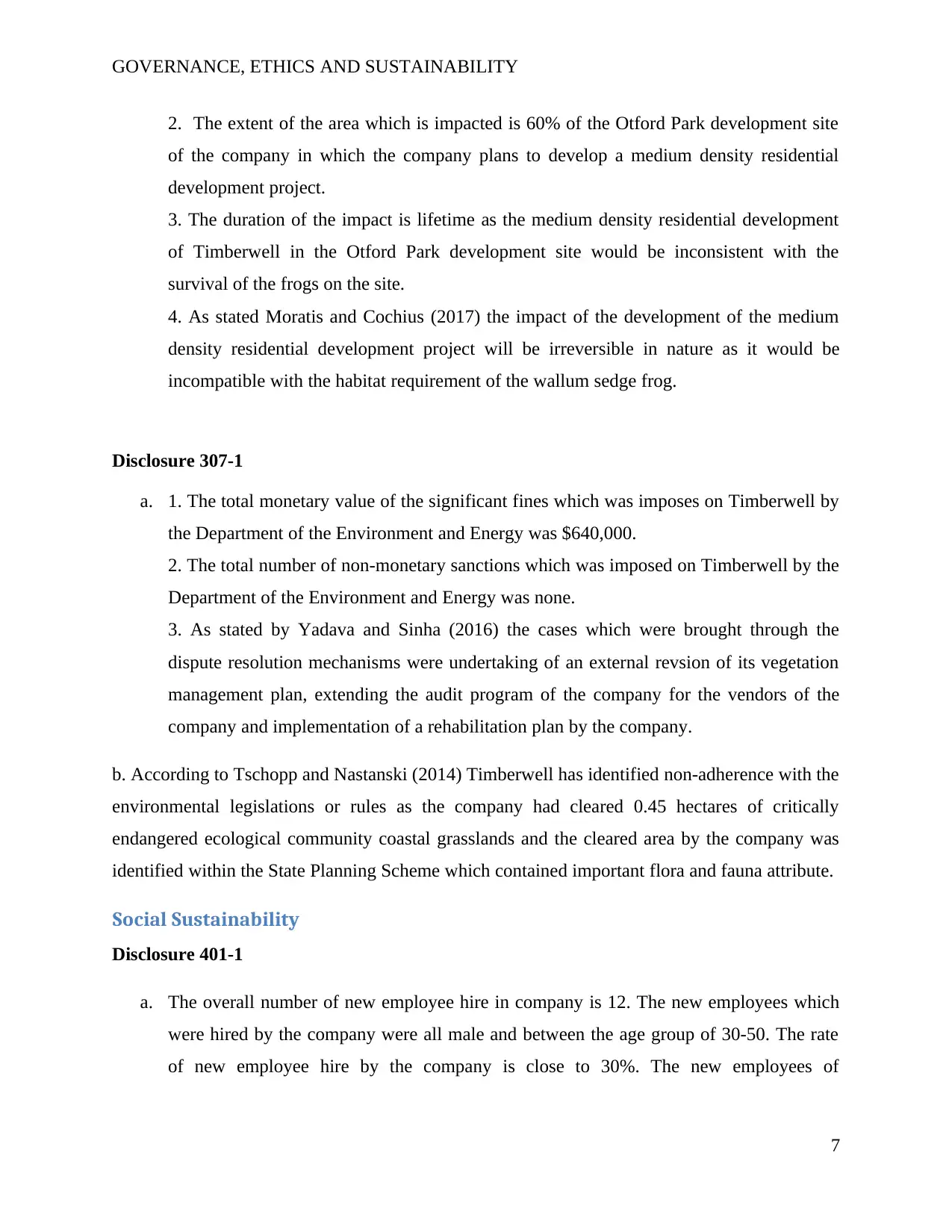
GOVERNANCE, ETHICS AND SUSTAINABILITY
2. The extent of the area which is impacted is 60% of the Otford Park development site
of the company in which the company plans to develop a medium density residential
development project.
3. The duration of the impact is lifetime as the medium density residential development
of Timberwell in the Otford Park development site would be inconsistent with the
survival of the frogs on the site.
4. As stated Moratis and Cochius (2017) the impact of the development of the medium
density residential development project will be irreversible in nature as it would be
incompatible with the habitat requirement of the wallum sedge frog.
Disclosure 307-1
a. 1. The total monetary value of the significant fines which was imposes on Timberwell by
the Department of the Environment and Energy was $640,000.
2. The total number of non-monetary sanctions which was imposed on Timberwell by the
Department of the Environment and Energy was none.
3. As stated by Yadava and Sinha (2016) the cases which were brought through the
dispute resolution mechanisms were undertaking of an external revsion of its vegetation
management plan, extending the audit program of the company for the vendors of the
company and implementation of a rehabilitation plan by the company.
b. According to Tschopp and Nastanski (2014) Timberwell has identified non-adherence with the
environmental legislations or rules as the company had cleared 0.45 hectares of critically
endangered ecological community coastal grasslands and the cleared area by the company was
identified within the State Planning Scheme which contained important flora and fauna attribute.
Social Sustainability
Disclosure 401-1
a. The overall number of new employee hire in company is 12. The new employees which
were hired by the company were all male and between the age group of 30-50. The rate
of new employee hire by the company is close to 30%. The new employees of
7
2. The extent of the area which is impacted is 60% of the Otford Park development site
of the company in which the company plans to develop a medium density residential
development project.
3. The duration of the impact is lifetime as the medium density residential development
of Timberwell in the Otford Park development site would be inconsistent with the
survival of the frogs on the site.
4. As stated Moratis and Cochius (2017) the impact of the development of the medium
density residential development project will be irreversible in nature as it would be
incompatible with the habitat requirement of the wallum sedge frog.
Disclosure 307-1
a. 1. The total monetary value of the significant fines which was imposes on Timberwell by
the Department of the Environment and Energy was $640,000.
2. The total number of non-monetary sanctions which was imposed on Timberwell by the
Department of the Environment and Energy was none.
3. As stated by Yadava and Sinha (2016) the cases which were brought through the
dispute resolution mechanisms were undertaking of an external revsion of its vegetation
management plan, extending the audit program of the company for the vendors of the
company and implementation of a rehabilitation plan by the company.
b. According to Tschopp and Nastanski (2014) Timberwell has identified non-adherence with the
environmental legislations or rules as the company had cleared 0.45 hectares of critically
endangered ecological community coastal grasslands and the cleared area by the company was
identified within the State Planning Scheme which contained important flora and fauna attribute.
Social Sustainability
Disclosure 401-1
a. The overall number of new employee hire in company is 12. The new employees which
were hired by the company were all male and between the age group of 30-50. The rate
of new employee hire by the company is close to 30%. The new employees of
7
Paraphrase This Document
Need a fresh take? Get an instant paraphrase of this document with our AI Paraphraser
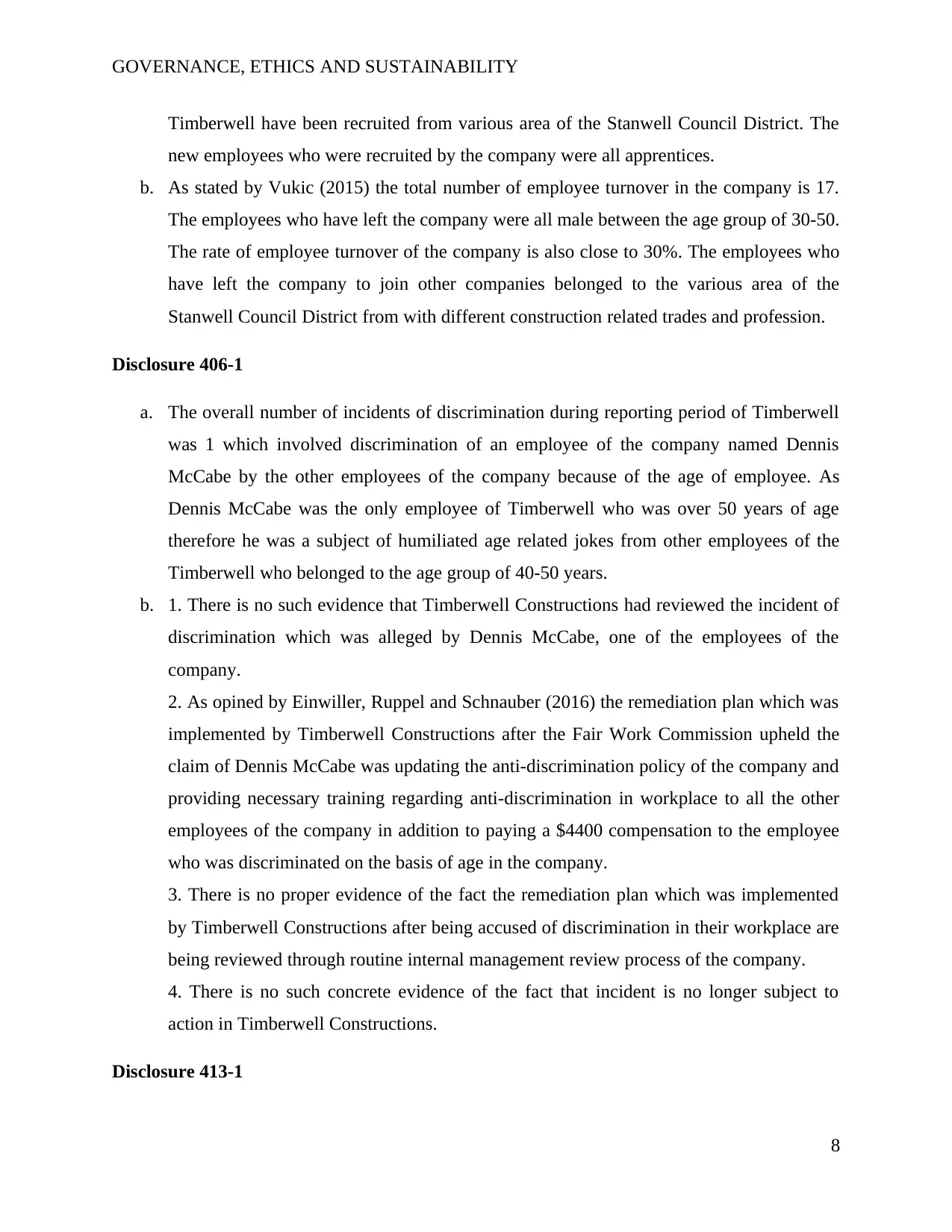
GOVERNANCE, ETHICS AND SUSTAINABILITY
Timberwell have been recruited from various area of the Stanwell Council District. The
new employees who were recruited by the company were all apprentices.
b. As stated by Vukic (2015) the total number of employee turnover in the company is 17.
The employees who have left the company were all male between the age group of 30-50.
The rate of employee turnover of the company is also close to 30%. The employees who
have left the company to join other companies belonged to the various area of the
Stanwell Council District from with different construction related trades and profession.
Disclosure 406-1
a. The overall number of incidents of discrimination during reporting period of Timberwell
was 1 which involved discrimination of an employee of the company named Dennis
McCabe by the other employees of the company because of the age of employee. As
Dennis McCabe was the only employee of Timberwell who was over 50 years of age
therefore he was a subject of humiliated age related jokes from other employees of the
Timberwell who belonged to the age group of 40-50 years.
b. 1. There is no such evidence that Timberwell Constructions had reviewed the incident of
discrimination which was alleged by Dennis McCabe, one of the employees of the
company.
2. As opined by Einwiller, Ruppel and Schnauber (2016) the remediation plan which was
implemented by Timberwell Constructions after the Fair Work Commission upheld the
claim of Dennis McCabe was updating the anti-discrimination policy of the company and
providing necessary training regarding anti-discrimination in workplace to all the other
employees of the company in addition to paying a $4400 compensation to the employee
who was discriminated on the basis of age in the company.
3. There is no proper evidence of the fact the remediation plan which was implemented
by Timberwell Constructions after being accused of discrimination in their workplace are
being reviewed through routine internal management review process of the company.
4. There is no such concrete evidence of the fact that incident is no longer subject to
action in Timberwell Constructions.
Disclosure 413-1
8
Timberwell have been recruited from various area of the Stanwell Council District. The
new employees who were recruited by the company were all apprentices.
b. As stated by Vukic (2015) the total number of employee turnover in the company is 17.
The employees who have left the company were all male between the age group of 30-50.
The rate of employee turnover of the company is also close to 30%. The employees who
have left the company to join other companies belonged to the various area of the
Stanwell Council District from with different construction related trades and profession.
Disclosure 406-1
a. The overall number of incidents of discrimination during reporting period of Timberwell
was 1 which involved discrimination of an employee of the company named Dennis
McCabe by the other employees of the company because of the age of employee. As
Dennis McCabe was the only employee of Timberwell who was over 50 years of age
therefore he was a subject of humiliated age related jokes from other employees of the
Timberwell who belonged to the age group of 40-50 years.
b. 1. There is no such evidence that Timberwell Constructions had reviewed the incident of
discrimination which was alleged by Dennis McCabe, one of the employees of the
company.
2. As opined by Einwiller, Ruppel and Schnauber (2016) the remediation plan which was
implemented by Timberwell Constructions after the Fair Work Commission upheld the
claim of Dennis McCabe was updating the anti-discrimination policy of the company and
providing necessary training regarding anti-discrimination in workplace to all the other
employees of the company in addition to paying a $4400 compensation to the employee
who was discriminated on the basis of age in the company.
3. There is no proper evidence of the fact the remediation plan which was implemented
by Timberwell Constructions after being accused of discrimination in their workplace are
being reviewed through routine internal management review process of the company.
4. There is no such concrete evidence of the fact that incident is no longer subject to
action in Timberwell Constructions.
Disclosure 413-1
8
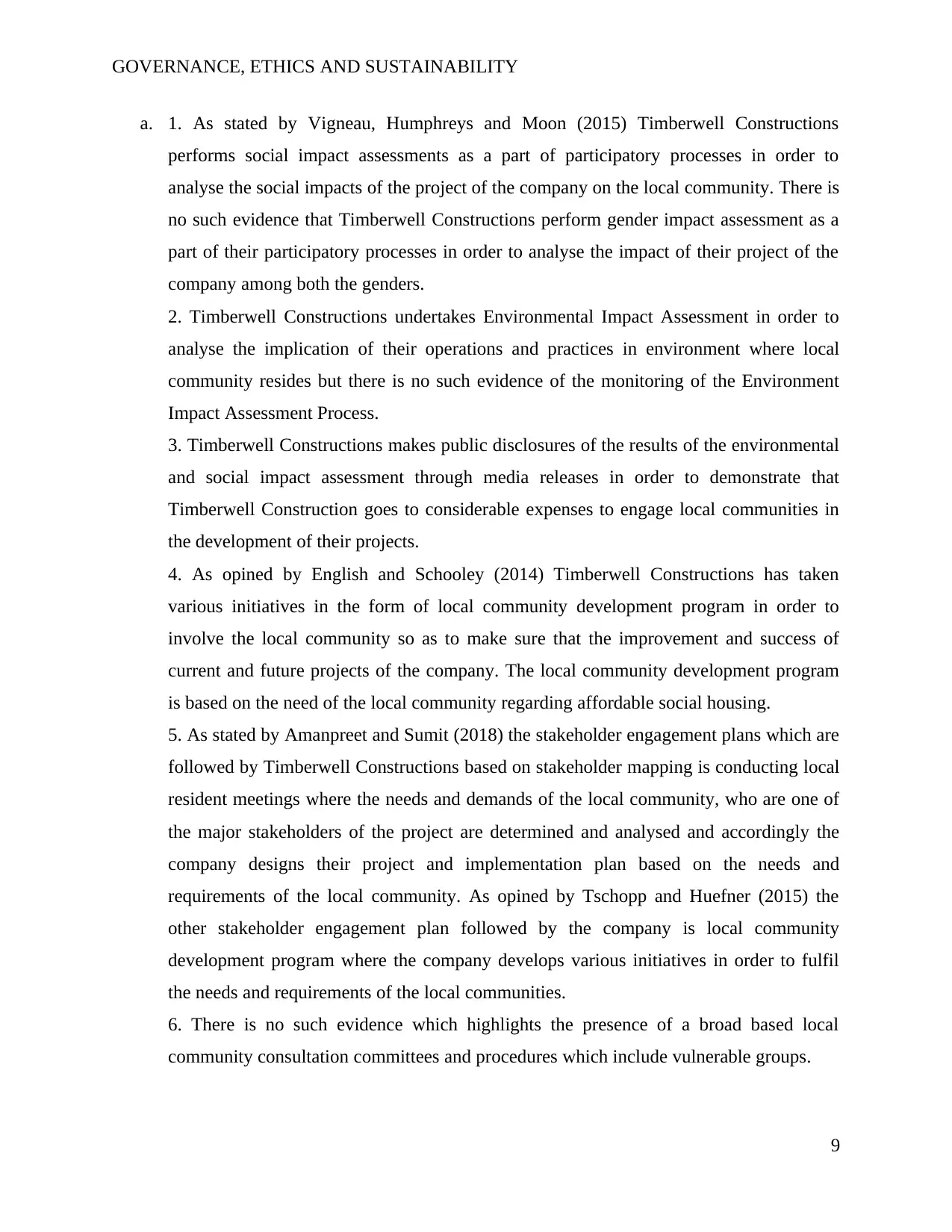
GOVERNANCE, ETHICS AND SUSTAINABILITY
a. 1. As stated by Vigneau, Humphreys and Moon (2015) Timberwell Constructions
performs social impact assessments as a part of participatory processes in order to
analyse the social impacts of the project of the company on the local community. There is
no such evidence that Timberwell Constructions perform gender impact assessment as a
part of their participatory processes in order to analyse the impact of their project of the
company among both the genders.
2. Timberwell Constructions undertakes Environmental Impact Assessment in order to
analyse the implication of their operations and practices in environment where local
community resides but there is no such evidence of the monitoring of the Environment
Impact Assessment Process.
3. Timberwell Constructions makes public disclosures of the results of the environmental
and social impact assessment through media releases in order to demonstrate that
Timberwell Construction goes to considerable expenses to engage local communities in
the development of their projects.
4. As opined by English and Schooley (2014) Timberwell Constructions has taken
various initiatives in the form of local community development program in order to
involve the local community so as to make sure that the improvement and success of
current and future projects of the company. The local community development program
is based on the need of the local community regarding affordable social housing.
5. As stated by Amanpreet and Sumit (2018) the stakeholder engagement plans which are
followed by Timberwell Constructions based on stakeholder mapping is conducting local
resident meetings where the needs and demands of the local community, who are one of
the major stakeholders of the project are determined and analysed and accordingly the
company designs their project and implementation plan based on the needs and
requirements of the local community. As opined by Tschopp and Huefner (2015) the
other stakeholder engagement plan followed by the company is local community
development program where the company develops various initiatives in order to fulfil
the needs and requirements of the local communities.
6. There is no such evidence which highlights the presence of a broad based local
community consultation committees and procedures which include vulnerable groups.
9
a. 1. As stated by Vigneau, Humphreys and Moon (2015) Timberwell Constructions
performs social impact assessments as a part of participatory processes in order to
analyse the social impacts of the project of the company on the local community. There is
no such evidence that Timberwell Constructions perform gender impact assessment as a
part of their participatory processes in order to analyse the impact of their project of the
company among both the genders.
2. Timberwell Constructions undertakes Environmental Impact Assessment in order to
analyse the implication of their operations and practices in environment where local
community resides but there is no such evidence of the monitoring of the Environment
Impact Assessment Process.
3. Timberwell Constructions makes public disclosures of the results of the environmental
and social impact assessment through media releases in order to demonstrate that
Timberwell Construction goes to considerable expenses to engage local communities in
the development of their projects.
4. As opined by English and Schooley (2014) Timberwell Constructions has taken
various initiatives in the form of local community development program in order to
involve the local community so as to make sure that the improvement and success of
current and future projects of the company. The local community development program
is based on the need of the local community regarding affordable social housing.
5. As stated by Amanpreet and Sumit (2018) the stakeholder engagement plans which are
followed by Timberwell Constructions based on stakeholder mapping is conducting local
resident meetings where the needs and demands of the local community, who are one of
the major stakeholders of the project are determined and analysed and accordingly the
company designs their project and implementation plan based on the needs and
requirements of the local community. As opined by Tschopp and Huefner (2015) the
other stakeholder engagement plan followed by the company is local community
development program where the company develops various initiatives in order to fulfil
the needs and requirements of the local communities.
6. There is no such evidence which highlights the presence of a broad based local
community consultation committees and procedures which include vulnerable groups.
9
⊘ This is a preview!⊘
Do you want full access?
Subscribe today to unlock all pages.

Trusted by 1+ million students worldwide
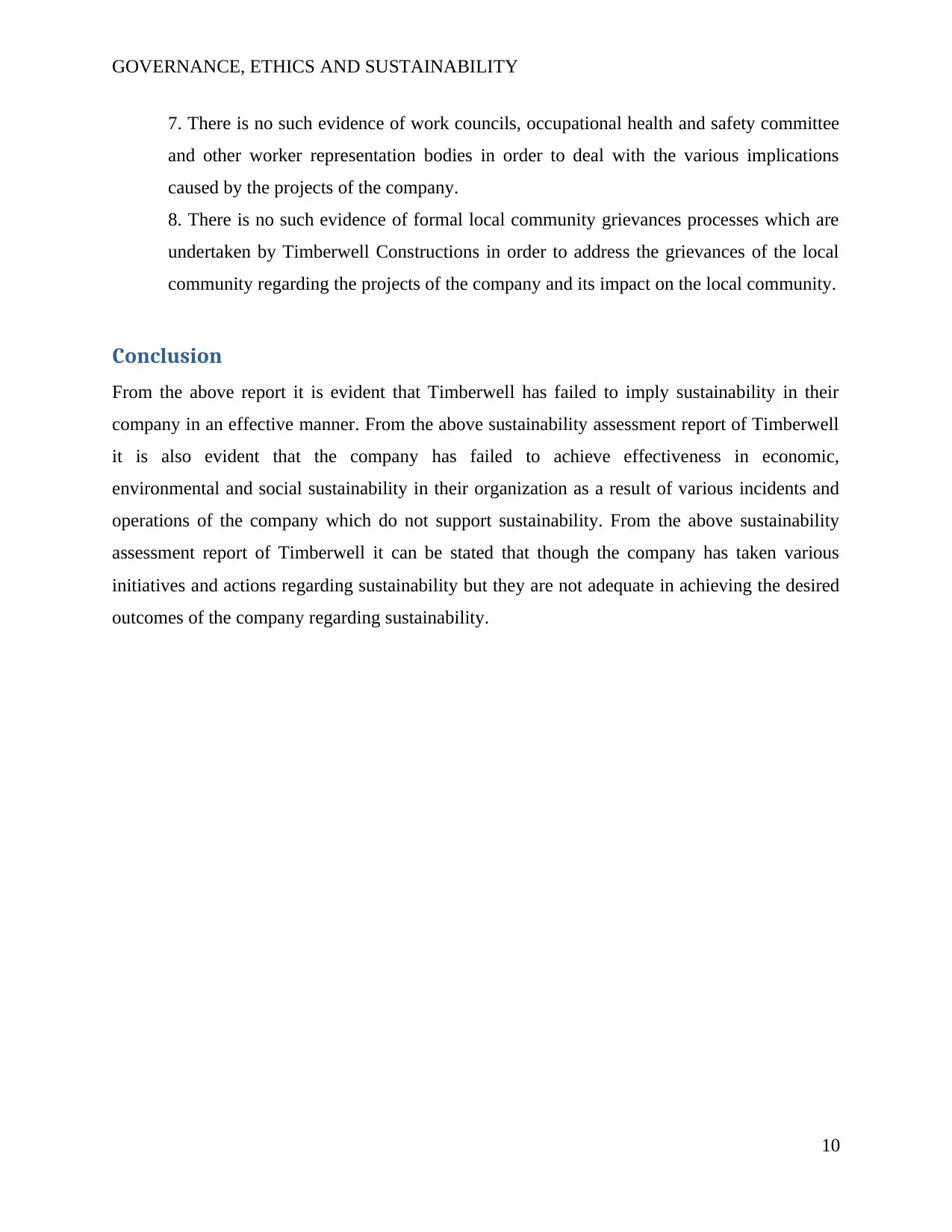
GOVERNANCE, ETHICS AND SUSTAINABILITY
7. There is no such evidence of work councils, occupational health and safety committee
and other worker representation bodies in order to deal with the various implications
caused by the projects of the company.
8. There is no such evidence of formal local community grievances processes which are
undertaken by Timberwell Constructions in order to address the grievances of the local
community regarding the projects of the company and its impact on the local community.
Conclusion
From the above report it is evident that Timberwell has failed to imply sustainability in their
company in an effective manner. From the above sustainability assessment report of Timberwell
it is also evident that the company has failed to achieve effectiveness in economic,
environmental and social sustainability in their organization as a result of various incidents and
operations of the company which do not support sustainability. From the above sustainability
assessment report of Timberwell it can be stated that though the company has taken various
initiatives and actions regarding sustainability but they are not adequate in achieving the desired
outcomes of the company regarding sustainability.
10
7. There is no such evidence of work councils, occupational health and safety committee
and other worker representation bodies in order to deal with the various implications
caused by the projects of the company.
8. There is no such evidence of formal local community grievances processes which are
undertaken by Timberwell Constructions in order to address the grievances of the local
community regarding the projects of the company and its impact on the local community.
Conclusion
From the above report it is evident that Timberwell has failed to imply sustainability in their
company in an effective manner. From the above sustainability assessment report of Timberwell
it is also evident that the company has failed to achieve effectiveness in economic,
environmental and social sustainability in their organization as a result of various incidents and
operations of the company which do not support sustainability. From the above sustainability
assessment report of Timberwell it can be stated that though the company has taken various
initiatives and actions regarding sustainability but they are not adequate in achieving the desired
outcomes of the company regarding sustainability.
10
Paraphrase This Document
Need a fresh take? Get an instant paraphrase of this document with our AI Paraphraser
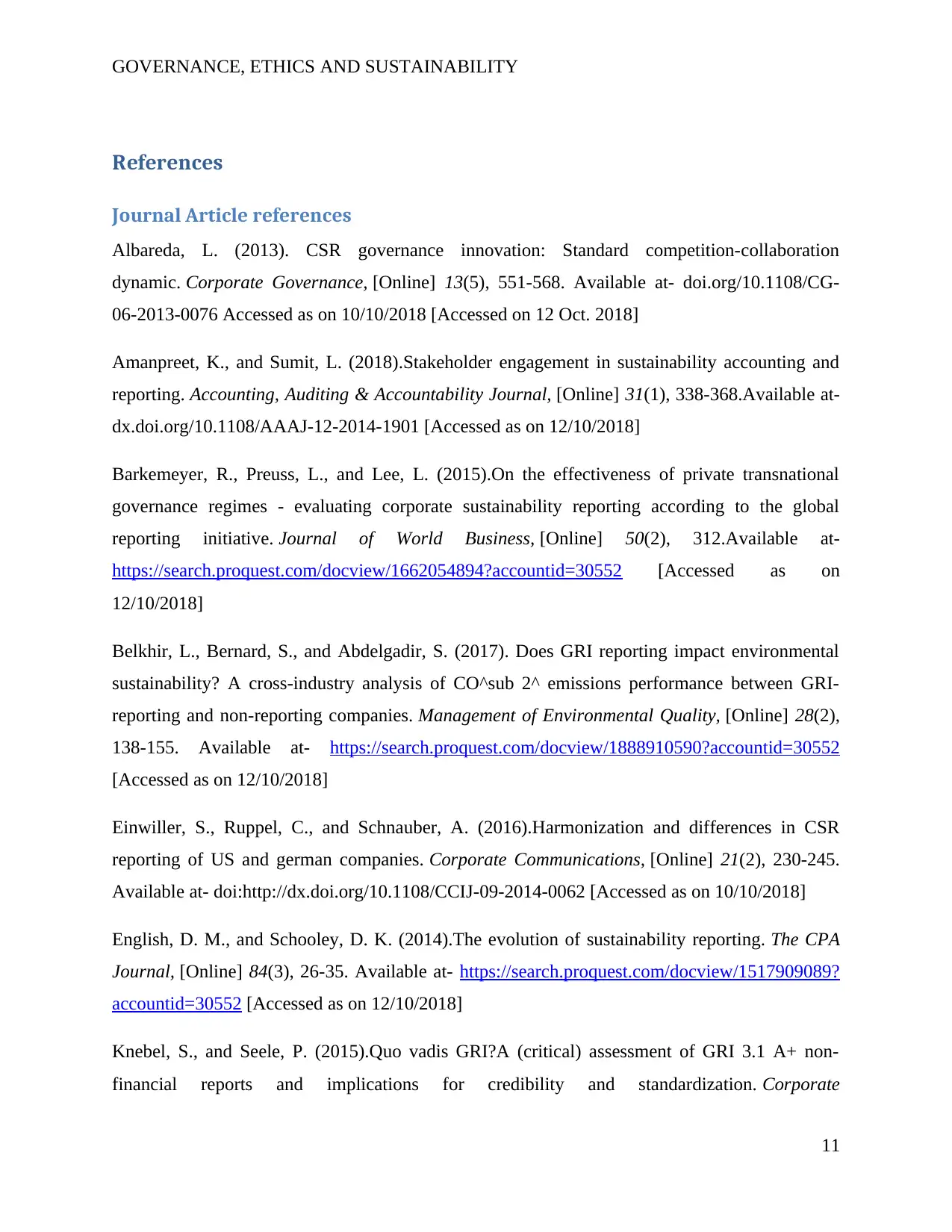
GOVERNANCE, ETHICS AND SUSTAINABILITY
References
Journal Article references
Albareda, L. (2013). CSR governance innovation: Standard competition-collaboration
dynamic. Corporate Governance, [Online] 13(5), 551-568. Available at- doi.org/10.1108/CG-
06-2013-0076 Accessed as on 10/10/2018 [Accessed on 12 Oct. 2018]
Amanpreet, K., and Sumit, L. (2018).Stakeholder engagement in sustainability accounting and
reporting. Accounting, Auditing & Accountability Journal, [Online] 31(1), 338-368.Available at-
dx.doi.org/10.1108/AAAJ-12-2014-1901 [Accessed as on 12/10/2018]
Barkemeyer, R., Preuss, L., and Lee, L. (2015).On the effectiveness of private transnational
governance regimes - evaluating corporate sustainability reporting according to the global
reporting initiative. Journal of World Business, [Online] 50(2), 312.Available at-
https://search.proquest.com/docview/1662054894?accountid=30552 [Accessed as on
12/10/2018]
Belkhir, L., Bernard, S., and Abdelgadir, S. (2017). Does GRI reporting impact environmental
sustainability? A cross-industry analysis of CO^sub 2^ emissions performance between GRI-
reporting and non-reporting companies. Management of Environmental Quality, [Online] 28(2),
138-155. Available at- https://search.proquest.com/docview/1888910590?accountid=30552
[Accessed as on 12/10/2018]
Einwiller, S., Ruppel, C., and Schnauber, A. (2016).Harmonization and differences in CSR
reporting of US and german companies. Corporate Communications, [Online] 21(2), 230-245.
Available at- doi:http://dx.doi.org/10.1108/CCIJ-09-2014-0062 [Accessed as on 10/10/2018]
English, D. M., and Schooley, D. K. (2014).The evolution of sustainability reporting. The CPA
Journal, [Online] 84(3), 26-35. Available at- https://search.proquest.com/docview/1517909089?
accountid=30552 [Accessed as on 12/10/2018]
Knebel, S., and Seele, P. (2015).Quo vadis GRI?A (critical) assessment of GRI 3.1 A+ non-
financial reports and implications for credibility and standardization. Corporate
11
References
Journal Article references
Albareda, L. (2013). CSR governance innovation: Standard competition-collaboration
dynamic. Corporate Governance, [Online] 13(5), 551-568. Available at- doi.org/10.1108/CG-
06-2013-0076 Accessed as on 10/10/2018 [Accessed on 12 Oct. 2018]
Amanpreet, K., and Sumit, L. (2018).Stakeholder engagement in sustainability accounting and
reporting. Accounting, Auditing & Accountability Journal, [Online] 31(1), 338-368.Available at-
dx.doi.org/10.1108/AAAJ-12-2014-1901 [Accessed as on 12/10/2018]
Barkemeyer, R., Preuss, L., and Lee, L. (2015).On the effectiveness of private transnational
governance regimes - evaluating corporate sustainability reporting according to the global
reporting initiative. Journal of World Business, [Online] 50(2), 312.Available at-
https://search.proquest.com/docview/1662054894?accountid=30552 [Accessed as on
12/10/2018]
Belkhir, L., Bernard, S., and Abdelgadir, S. (2017). Does GRI reporting impact environmental
sustainability? A cross-industry analysis of CO^sub 2^ emissions performance between GRI-
reporting and non-reporting companies. Management of Environmental Quality, [Online] 28(2),
138-155. Available at- https://search.proquest.com/docview/1888910590?accountid=30552
[Accessed as on 12/10/2018]
Einwiller, S., Ruppel, C., and Schnauber, A. (2016).Harmonization and differences in CSR
reporting of US and german companies. Corporate Communications, [Online] 21(2), 230-245.
Available at- doi:http://dx.doi.org/10.1108/CCIJ-09-2014-0062 [Accessed as on 10/10/2018]
English, D. M., and Schooley, D. K. (2014).The evolution of sustainability reporting. The CPA
Journal, [Online] 84(3), 26-35. Available at- https://search.proquest.com/docview/1517909089?
accountid=30552 [Accessed as on 12/10/2018]
Knebel, S., and Seele, P. (2015).Quo vadis GRI?A (critical) assessment of GRI 3.1 A+ non-
financial reports and implications for credibility and standardization. Corporate
11
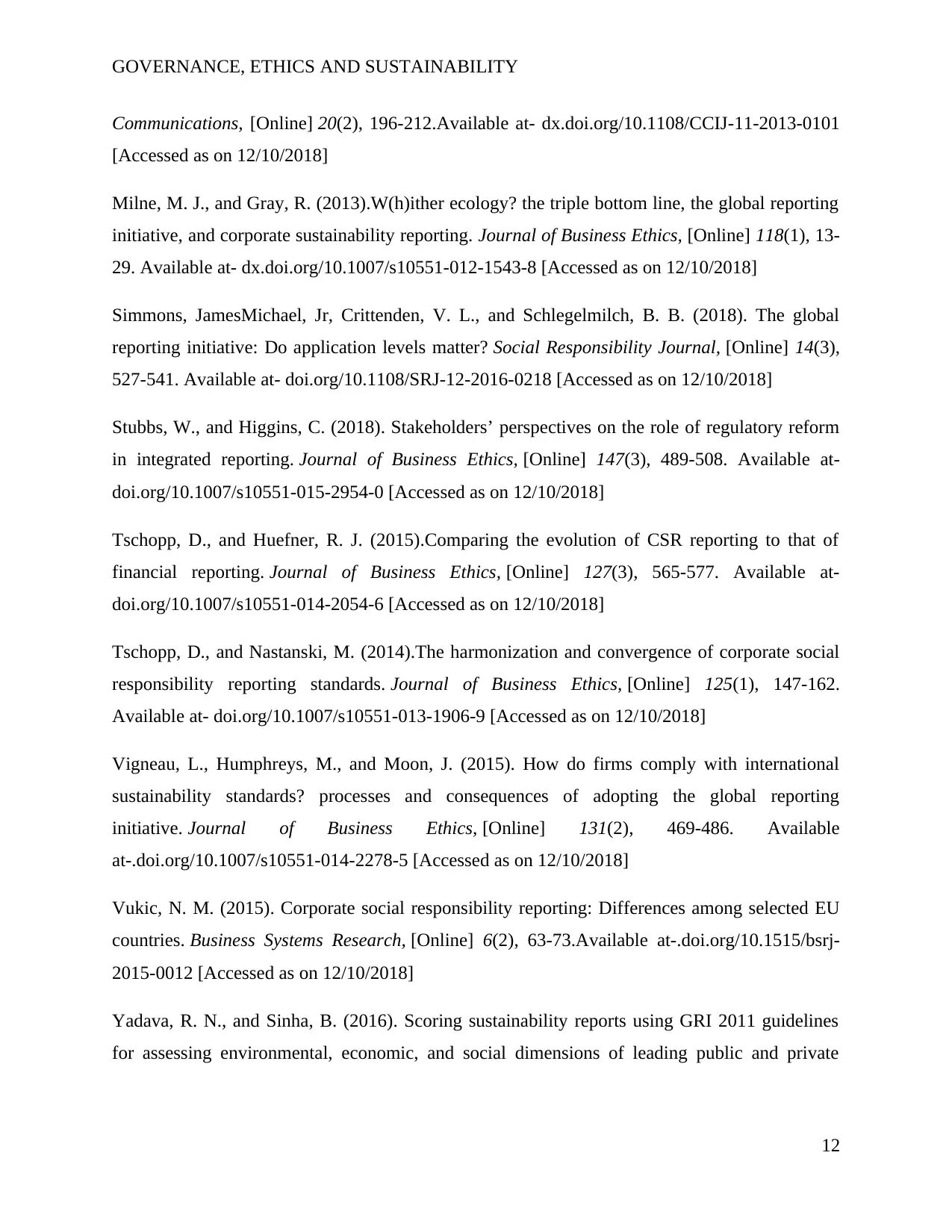
GOVERNANCE, ETHICS AND SUSTAINABILITY
Communications, [Online] 20(2), 196-212.Available at- dx.doi.org/10.1108/CCIJ-11-2013-0101
[Accessed as on 12/10/2018]
Milne, M. J., and Gray, R. (2013).W(h)ither ecology? the triple bottom line, the global reporting
initiative, and corporate sustainability reporting. Journal of Business Ethics, [Online] 118(1), 13-
29. Available at- dx.doi.org/10.1007/s10551-012-1543-8 [Accessed as on 12/10/2018]
Simmons, JamesMichael, Jr, Crittenden, V. L., and Schlegelmilch, B. B. (2018). The global
reporting initiative: Do application levels matter? Social Responsibility Journal, [Online] 14(3),
527-541. Available at- doi.org/10.1108/SRJ-12-2016-0218 [Accessed as on 12/10/2018]
Stubbs, W., and Higgins, C. (2018). Stakeholders’ perspectives on the role of regulatory reform
in integrated reporting. Journal of Business Ethics, [Online] 147(3), 489-508. Available at-
doi.org/10.1007/s10551-015-2954-0 [Accessed as on 12/10/2018]
Tschopp, D., and Huefner, R. J. (2015).Comparing the evolution of CSR reporting to that of
financial reporting. Journal of Business Ethics, [Online] 127(3), 565-577. Available at-
doi.org/10.1007/s10551-014-2054-6 [Accessed as on 12/10/2018]
Tschopp, D., and Nastanski, M. (2014).The harmonization and convergence of corporate social
responsibility reporting standards. Journal of Business Ethics, [Online] 125(1), 147-162.
Available at- doi.org/10.1007/s10551-013-1906-9 [Accessed as on 12/10/2018]
Vigneau, L., Humphreys, M., and Moon, J. (2015). How do firms comply with international
sustainability standards? processes and consequences of adopting the global reporting
initiative. Journal of Business Ethics, [Online] 131(2), 469-486. Available
at-.doi.org/10.1007/s10551-014-2278-5 [Accessed as on 12/10/2018]
Vukic, N. M. (2015). Corporate social responsibility reporting: Differences among selected EU
countries. Business Systems Research, [Online] 6(2), 63-73.Available at-.doi.org/10.1515/bsrj-
2015-0012 [Accessed as on 12/10/2018]
Yadava, R. N., and Sinha, B. (2016). Scoring sustainability reports using GRI 2011 guidelines
for assessing environmental, economic, and social dimensions of leading public and private
12
Communications, [Online] 20(2), 196-212.Available at- dx.doi.org/10.1108/CCIJ-11-2013-0101
[Accessed as on 12/10/2018]
Milne, M. J., and Gray, R. (2013).W(h)ither ecology? the triple bottom line, the global reporting
initiative, and corporate sustainability reporting. Journal of Business Ethics, [Online] 118(1), 13-
29. Available at- dx.doi.org/10.1007/s10551-012-1543-8 [Accessed as on 12/10/2018]
Simmons, JamesMichael, Jr, Crittenden, V. L., and Schlegelmilch, B. B. (2018). The global
reporting initiative: Do application levels matter? Social Responsibility Journal, [Online] 14(3),
527-541. Available at- doi.org/10.1108/SRJ-12-2016-0218 [Accessed as on 12/10/2018]
Stubbs, W., and Higgins, C. (2018). Stakeholders’ perspectives on the role of regulatory reform
in integrated reporting. Journal of Business Ethics, [Online] 147(3), 489-508. Available at-
doi.org/10.1007/s10551-015-2954-0 [Accessed as on 12/10/2018]
Tschopp, D., and Huefner, R. J. (2015).Comparing the evolution of CSR reporting to that of
financial reporting. Journal of Business Ethics, [Online] 127(3), 565-577. Available at-
doi.org/10.1007/s10551-014-2054-6 [Accessed as on 12/10/2018]
Tschopp, D., and Nastanski, M. (2014).The harmonization and convergence of corporate social
responsibility reporting standards. Journal of Business Ethics, [Online] 125(1), 147-162.
Available at- doi.org/10.1007/s10551-013-1906-9 [Accessed as on 12/10/2018]
Vigneau, L., Humphreys, M., and Moon, J. (2015). How do firms comply with international
sustainability standards? processes and consequences of adopting the global reporting
initiative. Journal of Business Ethics, [Online] 131(2), 469-486. Available
at-.doi.org/10.1007/s10551-014-2278-5 [Accessed as on 12/10/2018]
Vukic, N. M. (2015). Corporate social responsibility reporting: Differences among selected EU
countries. Business Systems Research, [Online] 6(2), 63-73.Available at-.doi.org/10.1515/bsrj-
2015-0012 [Accessed as on 12/10/2018]
Yadava, R. N., and Sinha, B. (2016). Scoring sustainability reports using GRI 2011 guidelines
for assessing environmental, economic, and social dimensions of leading public and private
12
⊘ This is a preview!⊘
Do you want full access?
Subscribe today to unlock all pages.

Trusted by 1+ million students worldwide
1 out of 14
Related Documents
Your All-in-One AI-Powered Toolkit for Academic Success.
+13062052269
info@desklib.com
Available 24*7 on WhatsApp / Email
![[object Object]](/_next/static/media/star-bottom.7253800d.svg)
Unlock your academic potential
Copyright © 2020–2025 A2Z Services. All Rights Reserved. Developed and managed by ZUCOL.




